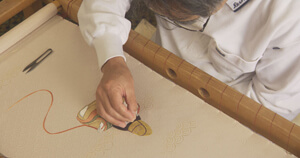- TOP
- Learn
- Learning at the Museum
- Museum Theater

Museum Theater
The Museum Theater screens high-definition short films and video programs relating to works in the museum's collection. Periodic screenings are held in the Lecture Theater, located on the museum's lower level.
- English language audio guides are available to rent for free.
- Video screenings may not be shown during Special Exhibitions and wing closures.
National Treasure Shakyamuni Rising from the Golden Coffin:
A Miraculous Moment of Amazement and Joy
Shakyamuni Rising from the Golden Coffin is a masterwork of Heian-period Buddhist painting that depicts a little-known legendary miracle of the historical Buddha Shakyamuni. This ultra high-definition video reveals the distinctive composition, rich colors, delicate cut gold leaf, reverse-applied pigments, and other sophisticated aspects of this National Treasure painting. Using meticulous research and the latest digital reproduction technology, it also revives the painting's lost pigments and ink strokes in order to reimagine its original appearance. (English audio guide available / about 15 min.)
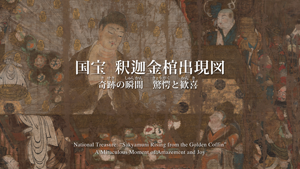
History and Masterworks of the Kyoto National Museum
For more than a century, the Kyoto National Museum has been a repository for the artistic legacy of Kyoto, the ancient Japanese capital of a thousand years. This program introduces the collecting, preservation, research, conservation, and other activities of this august institution over its long history. (English audio guide available / about 16 min.)
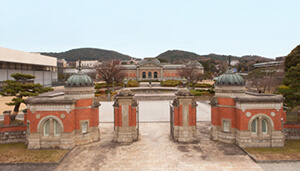
Fujiwara Clan's Sutra Container and Sutra Case:
The Prayers and Splendor of the Heian Aristocracy
This video delves into the historical and artistic significance of three National Treasure-designated sutra receptacles unearthed from the temple complex at Kinpusen, in Yoshino, Nara prefecture. The gilt bronze sutra container and two gold and silver-decorated bronze sutra boxes--one with paired birds and another with Buddhist flowers--originally held sutras that were buried as votive offerings by Fujiwara Michinaga (966–1028), once the most powerful regent in Japan, during a pilgrimage to the sacred mountain site. Through footage of present day Kinpusen and Enryaku-ji on Mt. Hiei, as well documentary evidence provided by Michinaga's diary Mido Kanpaku ki, we discover the historical and artistic significance of these National Treasures. Close up views of the inscriptions and the designs inscribed into these vessels give us a sense of the aspirations of their patron as well as the Pure Land adoration that was so prevalent in the culture of the Heian court. (English audio guide available / about 16 min.)
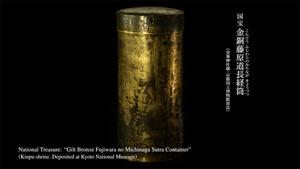
Letters from Sakamoto Ryōma:
A Hero's Appeal in the Closing Days of the Tokugawa Shogunate as Told through His Writing
Sakamoto Ryōma (1836–1867) is one of the most popular heroes of the nineteenth century ― a time when Japan ended its long seclusion and began to enter the modern era. This program examines the appeal of this visionary figure through his letters, many of which were donated to the Kyoto National Museum by the Sakamoto family and descendants of owners of the Ōmiya Inn in which Ryōma was assassinated. (English audio guide available / about 19 min.)
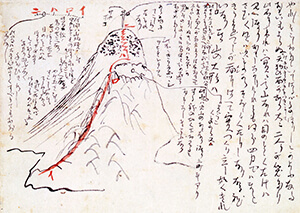
Wonder of View of Amanohashidate:
Superb View by Sesshū
View of Amanohashidate is a masterwork by painter Sesshū Tōyō (1420–1506), perhaps the best known Japanese artist of all time. The film investigates the actual peninsula depicted in this remarkable ink landscape and considers questions about its composition and creation. (English audio guide available / about 16 min.)

Kyoto Kimono:
Beauty and Craftsmanship Developed by the Inhabitants of Kyoto
Kyoto has long been Japan's center for the various industries used in kimono production, including weaving, dyeing, embroidery, and gold leaf application. This video introduces the advanced techniques used by contemporary textile artists and artisans in Nishijin and other areas of Kyoto. The ultra high-resolution imagery reveals details about these fabrics that would be hard to see with the naked eye, including the fibers' textures and the intricate, sophisticated artistry with which they are produced. (English audio guide available / about 20 min.)
